|
|
See below for the
Armenian Connection
In 1711, The Ottoman Turks had the upper hand (for once)
over the Russians, in the many wars the two foes fought over the centuries.
Peter the Great's lover, Catherine, may have been willing to lie upon her back
and think of Queen* and country in order to save the doomed Russian army.
(*Perhaps her soon-to-be-empress self)
 |
|
Peter
the Great
|
Perhaps as usual, Russia was engaged in the usual practice
of harassing the Ottoman Empire, with an eye on Istanbul and the Dardanelles
(and the all important passageway to the seas). Then again, it could have been
because Sweden's King Charles XII persuaded the Turks to give him a hand, as
Peter the Great had just dealt Sweden a crushing blow in the twenty one year
old war the two nations were involved with at the time. (Here's what the Swedish king thought of the
Turks.) Regardless of who declared war on whom, Peter the Great caught the
Turks at a time in history when they didn't quite settle in on their role of
the "Sick Man of Europe," and still packed a punch. Leading a newly
assembled and modernized Russian army, Peter rode off to face the enemy,
having faith in the help from his fellow Orthodox peoples in the Balkans...
particularly the Romanians (the czar had garnered promises of support from the
Princes of Moldavia and Valakia, from whom he expected 10,000 soldiers... the
Romanians had a way of lending a hand to the Russians during their wars with
the Turks, as with the Battle of Plevna).
Little did the czar realize the Ottoman Grand Vizier
and Commander-in-Chief, "Baltaci" (Translated as "Of the
Axe," or let's more colorfully say "The Axe Man") Mehmet Pasha
was lying in wake with an army of 80,000, reportedly three times the size as
the Russian commander's. (Actually, Peter was aware of being outnumbered, but
he was counting on the superiority of his modern weaponry to save the day.)
Peter the Great was stunned by the actions of the Turkish
army in the ensuing Battle of Pruth, and
quickly became aware all was close to being lost when his forces became
completely surrounded. While obviously a great leader who did many wonderful
things for Russia, he could sometimes be cruel (the picture below may be more
true-to-life than the potentially biased Turkish origin would indicate... I
understand, from impartial sources, Peter loved to use the whip on the people
of his court. The 6'8" giant was no doubt somewhat of an egomaniac) and a
bit soft in the head (the Turks disparagingly refer to him as "Deli Petro,"
or "Crazy Peter"), and it's reported (from a Turkish source) he
actually went a little bonkers over this turn of events, enough to be
bedridden. (Kind of like the way Stalin was paralyzed when his old pal Adolf
pulled a sneak "Pearl Harbor"-like attack during WWII... as fellow Aryans, the
Armenians, would with Azerbaijan
half a century later.) Catherine gave Peter hope, however, as she considered a
way to salvage the situation.
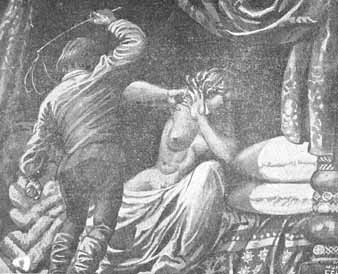 |
|
A
Turkish artist (Münif Fehim) depicted Peter the Great as
a cruel woman-beater, in this illustration, 1950 or earlier. For a
Moslem society, Turkey is much less uptight about showing
nudity in the general media, in contrast to the far more
sexually repressed United States... where such a picture
in a family magazine would be deemed "pornographic," even in
the 21st Century. (The Turkish magazine this picture is from
came out in 1950! When America was even more conservative,
not long before the "innocent" Dwight Eisenhower years.)
|
|
|
|
| Catherine
the Call Girl |
The story goes, Catherine surprised the Axe Man by
visiting him in his tent one evening. Once she got rid of her headdress, Mehmet Pasha
became aware of being in the presence of royalty, and was awestruck. She offered diamonds,
and then whispered, "Along with the diamonds, I'm yours." At this point, Mehmet
Pasha was at a loss for words (I guess there were witnesses to this event, like
Catherine's translator... that is, assuming this story is true)... however, he finally had
the wherewithal to close the "door" of the tent. One hour later, Catherine
emerged, her hair probably somewhat mussed.
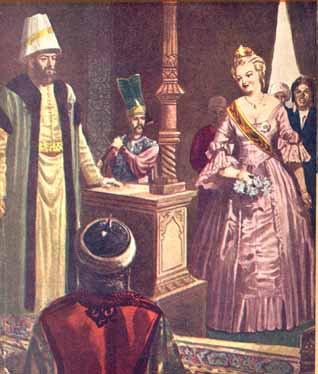 |
|
Turkish
artist (Münif Fehim) depicting Catherine's
impending royal sacrifice, in a painting from around 1950
Mehmet Pasha's semi-dunce cap seemed fitting for the
stupid way in which he behaved, if the tale is true.
|
|
Russia Survives to Kill Turks Another Day
|
Catherine threw her arms around Peter the Great
(most reports claim the couple officially married the following year, in 1712,
although it's possible the czar secretly got hitched to his lady love on Nov. 8,
1707), exclaiming that all was well. (Peter didn't seem to care about sharing his
lover/wife with another man... some macho tough guy he turned out to be.)
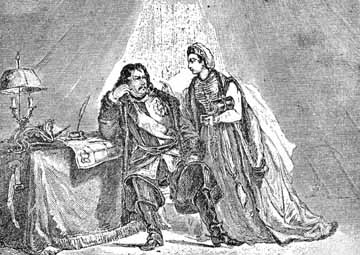
Unfortunately for the Ottoman Empire, The Axe
Man turned out to be one of those honorable Turks that even Turkey's enemies have
historically given credit for Turks of being. He kept his word, allowing the
Russians to safely withdraw. When one of his aides said the fate of the Russian army
was in their hands and the Ottomans were in a position to march to Moscow, the
Turkish commander refused to budge. Had he done otherwise, the fate of the Russian
nation could have been in dire trouble.
When the Axe Man returned to Istanbul, Sultan
Ahmet III was not too pleased; the Russians got off far too leniently (mainly giving
up their conquests on Azov, which Peter the Great took from the Ottomans' Crimean
Tatar vassals in the two campaigns of 1695-1696), and the Axe Man was accused of
taking bribes. Dishonored, he was axed... and perhaps assigned to duty in dangerous
islands of the Empire that insured his death.
Andrew Wheatcroft sheds further light, from
"The Ottomans," 1993 (p. 77):
A great triumph could be as
dangerous as defeat, as it was for the commanders who defeated the Russians at
the battle of the river Pruth in 1711. Sir Robert Sutton, the English
ambassador to the Sublime Porte, revealed the mysterious logic of the Ottoman
court when he wrote in his dispatch of 21 November 1711:
Vizier Azem Mehmet Pasha being deposed… the late Vizier’s creatures and
confidants, viz. Omar Efendi (his Chief Secretary), the Secretary of the Corps
of Janissaries, the commander of the Sipahis, and his reporter, were cast into
prison . . . three days after Osman Aga who was his Chief of Staff ... was
imprisoned here. It is believed that none of them will be punished with loss
of life but only with drawing their purses.”5
One month later he was writing, with some surprise, ‘On the 14th instant
afternoon Osman Aga, who was the late Vizier Azem’s Chief of Staff at the
Conclusion of the Peace, and Omar Efendi, his Chief Secretary, were beheaded
before the Great Gate of the Seraglio, and the bodies left exposed.”6 They
had the misfortune to serve a sultan who had come to the throne through the
deposition of his brother and who feared a victorious army more than he feared
a defeated one.
5. Kemal Zadeh Pasha, Histoire de la campaigne de Mohacs
(Paris, 1859)
6.
Christopher Duffy, Siege Warfare: the Fortress in the Early Modern World,
1494-1660 (London, 1979)
|
I'll bet if the tables were turned and a Turkish
"princess" similarly visited Peter the Great, in a last-ditch effort to
save her army from certain doom, Peter would have had his cake and eaten it, too.
After all, if Peter lied to the Armenians, he probably would not
have kept his word to a Turkish lady, after he wham-bam-thank-you-ma'am'ed her.
|
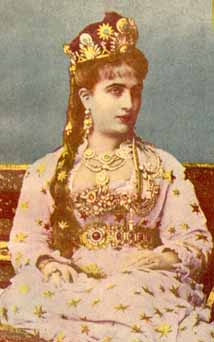
|
|
Princess
Tevhide, in a colorized photo
|
(A Turkish princess? I don't know
much about this area, as we rarely hear about the women of the extremely
male-dominated Ottoman Empire, save for the ladies of the harem. I suppose they existed... such as Princess Tevhide,
[pictured right] who was the daughter of a Hidiv Ismail Pasha, during the reign of
Sultan Abdülâziz...
around the 1860s. This is from the only Turkish history "book" I have,
inherited from my father, a bound collection of "Illustrated History
Magazine," where I got some of the images to decorate this site with.)
Did the Axe Man lose his senses and think with
his "little brain"? This is a colorful yarn, and it would be fun if it's
true. For all Mehmet Pasha knew, the woman who appeared in his tent was nothing more
than Peter the Great's mistress. (Although Catherine was declared as czarina during
1711... probably, in fact, by the time these events took place.) At least Mehmet Pasha
began the tradition of Turkish men falling for Russian working girls... after the Iron
Curtain's fall, many "Natasha's" journeyed to Turkey, hungry to make a buck.
Turkish wives sometimes lacking in
sexual adventurism, the sudden availability of alternatives threatened to rock the
foundation of quite a few marriages.
If the story is true (an unofficial Swedish
history I've read concluded nobody knows why Mehmet Pasha decided on his non-course of
action, and an American report I've come across had this to say about why the Russians
were let off so easily: The Turks were "inept negotiators"), the pasha
performed an awful disservice to his nation... coming from a long stretch of what is
known as The Catastrophic Years, the Ottoman Empire was alone in combating a
powerful alliance: The German and Russian empires, the Polish Kingdom, the Venetians,
the Austrians, and then there was Iran nipping at the Ottomans' heels. A decisive
victory against the Russians would have been just what the doctor ordered. (When the
Russians found themselves finally holding the upper hand when the Turkish army was
similarly surrounded... at Plevna... barely a
Turkish P.O.W. was left alive.)
Most of the foregoing
was taken from an article by Ziya Sakir, from the April 1950 issue of "Resimli
Tarih Mecmuasi," or "Illustrated History Magazine."
ADDENDUM:
Some
Other Turks Say...
A 1955 15-page booklet (the text of a seminar held by the Association of
Nationalists) entitled “Baltaci’nin Prut Zaferi” (Baltaci’s Pruth
Victory) by Ismail Hami Danismend, gives us another side to the story.
The two accusations addressed are 1) Catherine’s lovey-dovey gestures and
bribery with jewels resulted in the Ax Man’s thinking with his little ax,
allowing him to lose the opportunity to wipe up the floor with Peter the
Great, and 2) The Ax Man and his attendants were unskillful, incapable and
dishonorable, as opposed to the Russians, who were ready to sacrifice all.
The book portrays the Ax Man as a hero and victor, because the Russians were
forced to keep their distance from the Black and Azak Seas, borders were
withdrawn further north, Turkish castles were returned, and the King of Sweden
was allowed to return home. Why didn’t the Ax Man go for broke? After 3 days
of war, the Turkish Army was unwilling to fight. This assertion is reportedly
supported by testimonies of different people. (If the Janissaries — who were
becoming awfully “picky” by this time — were involved, this is probably
truer than one could imagine.) The author also argues that the decision for
peace was undertaken by the council of war, and not just by the
Commander-in-Chief.
As offering ransom by a defeated party was a tradition, the received gifts
could not be constituted as bribery, the author argues... moreover, these
gifts were distributed to othes, even Catherine’s ring. Reportedly supported
by references, the Ax Man is claimed to have lost his fortune after the
battle, instead of becoming richer... due to the war’s expenses. (Huh? Isn’t
it the government that is supposed to pay for such expenses?)
Since only male delegates were allowed into headquarters (probably true in the
sexist Ottoman society... but wouldn’t an exception have been made with
royalty? Even if Catherine wasn’t officially the czarina, by this time, didn’t
being Peter’s main squeeze count for anything?), Catherine never even paid
the visit. The author is quoted on p. 10: that “It is not possible that her
lover (Peter) sent her to Turkish headquarters with the duty of prostitution.”
I guess the Turkish author is now stressing “The Great” part of Peter
instead of the “Crazy” part. Who really can say, if the alternative was
severe national loss, including the possible loss of his own life. (Let’s
see... an hour’s worth of “disgrace” for my “wife,” versus my life.
Hmmmm..... )
The author concludes by saying that remembering the glory of Baltaci Mehmet is
his national duty and a duty of conscience. (Cue the blaring of trumpets.)
Well.... despite the nationalist source, this account is probably closer to
the truth. Regardless, the other version is so much more FUN.
Thanks to
Ibrahim and K.C.
|
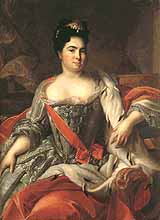 |
|
Catherine
I
|
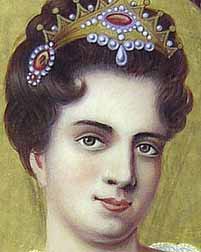 |
|
Apple
of the Axe Man's eye
|
Catherine (1684 -1727) was a
peasant girl born as Marta Skowronskain in Lithuania (some say Latvia); forced to
serve three different Russian officers, she was brought to Peter's attention once
the leader dined with the last of these (Prince Menshikov). Since the czar was no
longer intoxicated by wife Eudoxia, he and Catherine became nearly inseparable.
After the emperor (a title Peter gave himself after the 21-year-old war with Sweden
netted his nation lots of new land) died in 1725, Catherine became the empress.
Although illiterate, she ironically opened Russia's esteemed Academy of
Science. Her reign did not last long, and she died two years after her ascension.
Not long after, Catherine Number One would lead
to Number Two!
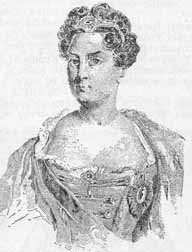 |
|
Catherine
the Great, from an old
English history book
|
Catherine
the Great would take charge of her country in later years (1762-1796) and wage a
number of wars against the Ottomans. Her first war ended in the Treaty of Kuchuk
Kaynarca (1774) by which the Ottomans gave up the Crimea, the first time they had
lost territory inhabited primarily by Muslims. The Sick Man began hitting its period
of decline in earnest... by the time Catherine's second war with the Ottomans began,
in 1789, Selim lll became sultan; he failed to prevent Napoleon’s invasion of the
rich Ottoman province of Egypt (in 1798), Europeans became aware of the balance of
power decidedly shifting in their favor.
A Quote by the Tsarina:
For to tempt and to be tempted are things very nearly allied...
whenever feeling has anything to do in the matter, no sooner is it excited than we
have already gone vastly farther than we are aware of.
(Catherine was obviously one
clever and sensuous lady:)
Arriving in Russia at the age of 15, the German
princess Catherine married her temperamentally troubled, paranoid, immature and
mentally-unstable cousin a year later. (Grand Duke Carl Peter Ulrich -- duke of
Holstein-Gottorp and heir to the Russian throne.) Later admitting that she was more
interested in Peter's attainment of the crown than in "the person" of
Peter, her marriage was soon tarnished by Peter's infidelity — behavior which
Catherine was quick to imitate. Catherine embarked upon what was to become one
of the most scandalous amorous reputations in history, pursuing numerous affairs and
liaisons. In contrast to her husband, who continued to publicly express his
preference for his native Germany, Catherine put aside her own Germanic roots in
favor of immersing herself with all things Russian, in preparation for the role of
empress. Soon after Peter became emperor, Catherine decided to partake in the
inevitable coup. In June 1762, the emperor was overthrown and subsequently killed
"in an accident," while Catherine became Russia's autocratic ruler...
declaring herself Empress Catherine II.
|
| "The Greats"... Peter & Catherine... and the Armenians |
The following excerpt is by Turkish professor Salahi R. Sonyel's
authenticated essay entitled, DISINFORMATION:THE
NEGATIVE FACTOR IN TURCO-ARMENIAN RELATIONS:
Tsar Peter ‘the Great’ (reigned 1689-1725) used them (the Armenians) in his grandiose schemes to invade the Caucasus,
where the overwhelming majority of the people was Muslim. He made lavish promises to them,
which he did not keep. Under Catherine II (reigned 1762-1796), the supreme commander,
Prince Potemkin, dreamt of an Armenian kingdom under Russian control,(11) but ultimately
he and Catherine, too, let them down.(12) Despite their disheartening experiences,
Armenian secular and religious leaders supported Russia in its invasion of the Muslim
countries of the Caucasus, acting as informers for the Russians against their Muslim
rulers, the Persians.(13) In many ways, the enmity
that developed between the Armenians and Turks, including other Muslims, had its roots
in Russian expansion into the Caucasus.
(11) M. S. Anderson, The Eastern Question, London, 1978, p.
11.
(12) Lang, People in Exile, pp. 111-12; Charles N. Eliot, Turkey in Europe, London,
1900, p. 394; Koça?, p. 273
(13) Muriel Ann Atkin, The Khanates of the Eastern Caucasus
and the Origins of the First Russo-Iranian War, doctoral dissertation, Yale University,
1978, pp. 25-27
Holdwater adds: Those kwazy Armenians! The
roots of the Russians' attempting to pull the wool over their eyes began as early as Peter
the Great's reign... and although the Russians kept breaking their word over and over and
over again... the Armenians just kept trusting them. When their great "guardian"
finally betrayed them once
AGAIN in 1915, you get one guess as to whom the Armenians blamed. The Russians? Nope.
Themselves? Uh-uh! You know that wouldn't be an Armenian thing to do, would it... to
accept responsibility for their own actions..?
|
|